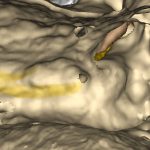This is a collection of frequently asked questions about the VOXEL-MAN 3D Printing application.
1 What is VOXEL-MAN 3D Printing?
VOXEL-MAN 3D Printing is an optional simulator app that allows you to create anatomical and surgical 3D model files for 3D printing. It can be combined with all VOXEL-MAN surgical and dental training simulators.
2 How does it work?
Simply at the touch of a button, at any time before, during or after a virtual intervention on the simulator. There is no limitation to the number of model files that can be stored, so you can create a model at any stage of a virtual surgery.
3 Is there a 3D printer included?
No, a 3D printer is not included, but you can most likely print the models with your favorite 3D printer.
4 Does it work with my 3D printer?
Most likely, yes. VOXEL-MAN 3D Printing supports all popular 3D printing formats including Wavefront (OBJ), Stereolithography (STL), Additive Manufacturing (AMF) and 3D Manufacturing (3MF), making it compatible with almost all 3D printers.
Note however that 3D models created from medical image data tend to be considerably larger and more complex than conventional models created with CAD or 3D modeling applications. Therefore, they cannot be guaranteed to be suitable for every 3D printer.
3D Models created with the 3D printing app have been successfully tested with various 3D printers in a wide price range, including
- Bambu Lab X1 Carbon
- Prusa I3 MK3S
- Stratasys J55
- Ultimaker S3
Let us know if you are interested to have your 3D printer type tested.
5 How is the workflow?
The print file created with the simulator is read by a slicer app. The slicer usually comes with the 3D printer, but you can also use a generic slicer such as Cura or Slic3r.
The slicer generates specific instructions for the 3D printer to print the model layer by layer (hence the name). The output of the slicer is again a file, which is sent to the 3D printer.
After the model has been printed, some mechanical post-processing may be required, such as removing supports.
6 How big are the printed models?
They are printed exactly to scale, i.e. in real life size, using the geometric information contained in the underlying DICOM images. Most slicers also allow you to select a scaling factor for magnification.
7 How long does it take to print a 3D model?
This depends on the size of the model, the printer, filament, single or a multi material printing, and the print quality. A typical time is a couple of hours.
8 Which filaments can be used?
The 3D printing files created with VOXEL-MAN 3D Printing are suitable for all 3D printing technologies, including depositing molten filaments, gluing or (laser) sintering of powders, and curing liquids. You can use thermoplastic polymers such as PLA, ABS, TPU or PETG, but also plaster-like materials and even metals like gold and titanium, as well as ceramics.
9 How accurate are the models?
A preliminary study shows a very good agreement between virtual and 3D printed models.
10 Can I print 3D models for wet lab training?
Basically, yes. Note however that not all printing materials are suitable for drilling and milling (e.g. low melting temperature, hazardous vapors). Make absolutely sure that you only use suitable materials!
11 Can I use clinical data to create training models?
Yes, you can import CT or CBCT images with VOXEL-MAN My Cases and print the model with VOXEL-MAN 3D Printing.
12 Can I use it to create patient specific implants?
No. VOXEL-MAN ENT is a training device for surgical education. It has not been released by VOXEL-MAN for treatment of human beings and has no regulatory approval for this purpose.
13 Can I further process the 3D model files?
Yes, with a 3D modeler. Free 3D modelers include Microsoft 3D Builder (pre-installed in Microsoft Windows 10), Autodesk Meshmixer and MeshLab.
Back to VOXEL-MAN 3D Printing

